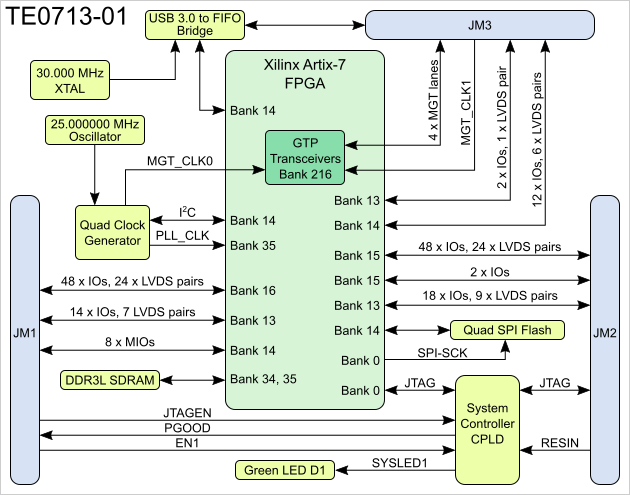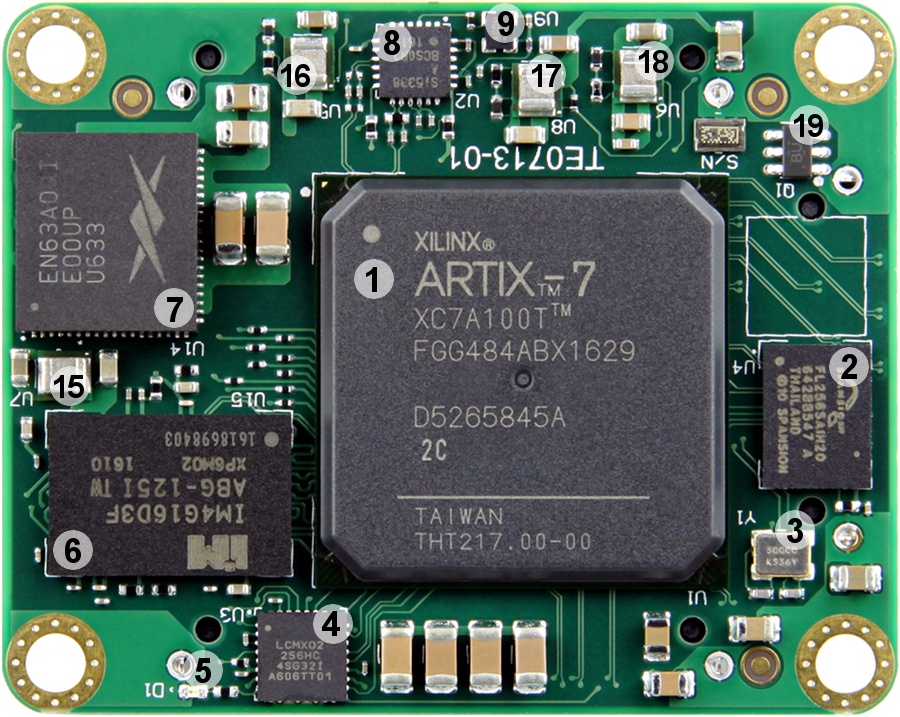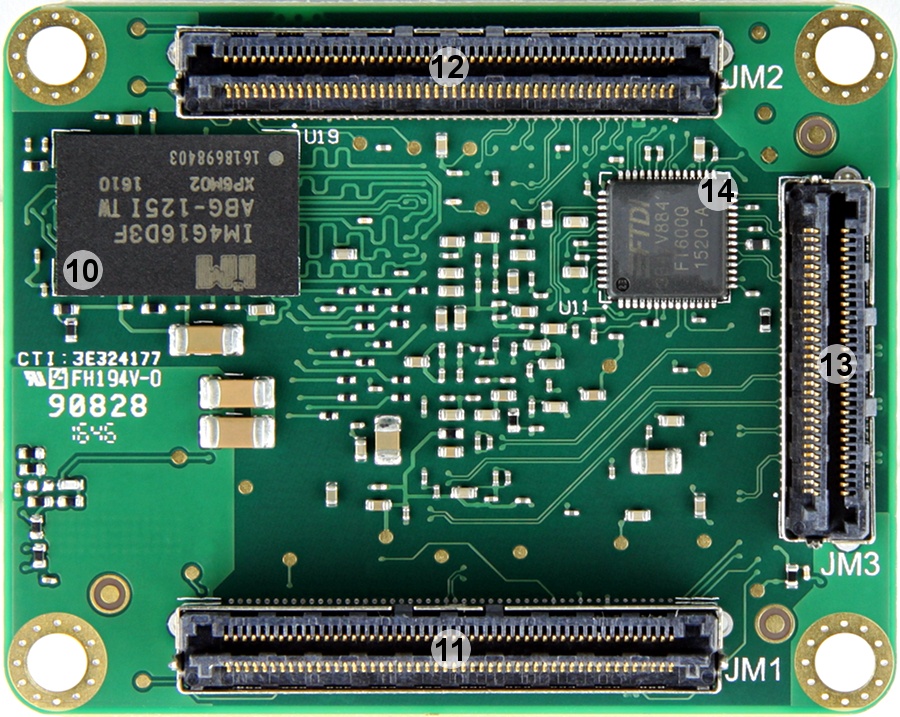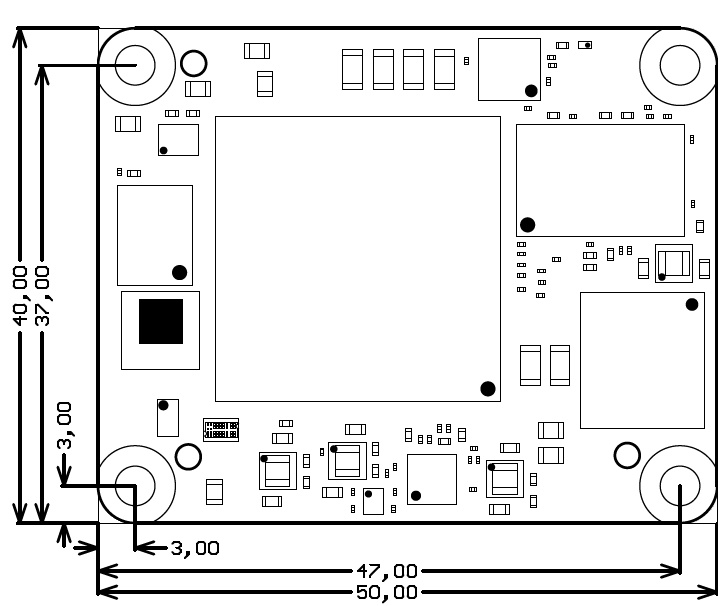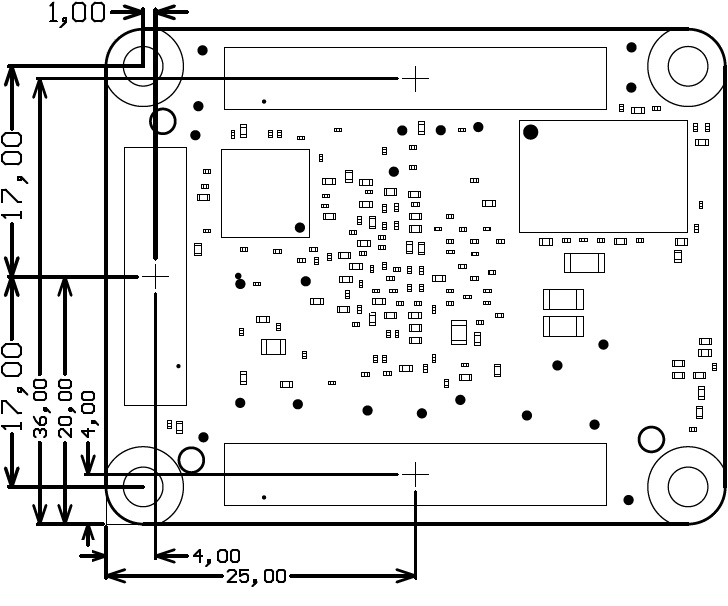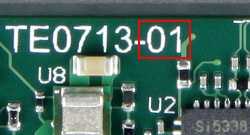Table of Contents
Overview
Trenz Electronic TE0713 is an industrial-grade FPGA module integrating Xilinx Artix-7 FPGA, USB 3.0 to FIFO bridge, 1 GByte of DDR3L SDRAM, 32 MByte Flash memory for configuration and operation, and powerful switching-mode power supplies for all on-board voltages. Numerous configurable I/Os are provided via rugged high-speed strips. All this on a tiny footprint, smaller than a credit card size at very competitive price. All Trenz Electronic SoMs in 4 x 5 cm form factor are mechanically compatible.
Key Features
- Xilinx Artix-7 (15T to 200T) series FPGA
- Both industrial and commercial temperature ranges available
- Rugged for high shock and high vibration resistance
- 1 GByte DDR3L 32-bit SDRAM
- 32 MByte QSPI Flash memory (with XiP support)
- USB 3.0 to FIFO interface bridge
- Programmable clock quad generator
- GTP transceiver clock (default 125 MHz)
- Fabric clock (default 200 MHz)
- GTP transceiver clock (default 125 MHz)
- Plug-on module with 2 × 100-pin and 1 × 60-pin high-speed hermaphroditic strips
- 152 FPGA I/Os (75 differential pairs) available via B2B connectors
- 4 GTP (multi Gigabit transceiver) lanes
- External clock input for GTP transceivers via B2B connector
- On-board high-efficiency DC-DC converters
- System management and power sequencing
- eFUSE bit-stream encryption
- AES bit-stream encryption
- User configurable LED
Evenly-spread supply pins for good signal integrity
Additional assembly options are available for cost or performance optimization upon request.
Block Diagram
Main Components
- Xilinx Artix-7 XC7A series FPGA, U1
- 32 MByte QSPI Flash memory, U4
- 30.000 MHz quartz crystal, Y1
- System Controller CPLD, Lattice Semiconductor MachXO2-256HC, U3
- Green LED (SYSLED1), D1
- 4 Gbit DDR3L 256M x 16 SDRAM, U15
- Altera Enpirion 12A PowerSoC DC-DC converter, U14
- Silicon Labs programmable quad clock generator, U2
- SiTime low-power programmable oscillator @ 25.000000 MHz, U9
- 4 Gbit DDR3L 256M x 16 SDRAM, U19
- Samtec Razor Beam™ LSHM-150 B2B connector, JM1
- Samtec Razor Beam™ LSHM-150 B2B connector, JM2
- Samtec Razor Beam™ LSHM-130 B2B connector, JM3
- FTDI USB 3.0 to FIFO interface bridge, U11
- Texas Instruments 3A step-down converter (DDR_PWR), U7
- Texas Instruments 3A step-down converter (1.8V), U5
- Texas Instruments 3A step-down converter (1.2V_MGT), U8
- Texas Instruments 3A step-down converter (1V_MGT), U6
- Texas Instruments PFET load switch, Q1
Initial Delivery State
Programmable unit | Content | Notes |
|---|---|---|
| Xilinx Artix-7 FPGA | Not programmed | U1 |
| System Controller CPLD | Programmed | U3 |
| SPI Flash OTP area | Empty | U4 |
SPI Flash main array | Empty | U4 |
| SPI Flash Quad Enable bit | Set | U4 |
Signals, Interfaces and Pins
Board to Board (B2B) I/Os
FPGA banks and I/O signals connected to the B2B connectors:
| FPGA Bank | B2B Connector | I/O Signal Count | Voltage Level | Notes |
|---|---|---|---|---|
| 13 | JM1 | 14 | VCCIO13 | Supplied by the baseboard. |
| 13 | JM2 | 18 | VCCIO13 | Supplied by the baseboard. |
| 13 | JM3 | 2 | VCCIO13 | Supplied by the baseboard. |
| 14 | JM1 | 8 | 3.3V | |
| 14 | JM3 | 12 | 3.3V | |
| 15 | JM2 | 48 | VCCIO15 | Supplied by the baseboard. |
| 15 | JM2 | 2 | VCCIO15 | Supplied by the baseboard. |
| 16 | JM1 | 48 | VCCIO16 | Supplied by the baseboard. |
JTAG Interface
JTAG access to the Xilinx Artix-7 FPGA and System Controller CPLD devices is provided through B2B connector JM2.
JTAG Signal | B2B Pin |
|---|---|
| TMS | JM2-93 |
| TDI | JM2-95 |
| TDO | JM2-97 |
| TCK | JM2-99 |
JTAGEN pin in B2B connector JM1 is used to select JTAG access for FPGA or System Controller CPLD:
| JTAGEN | JTAG Access To |
|---|---|
| Low | Artix-7 FPGA |
| High | System Controller CPLD |
System Controller I/O Pins
Special purpose pins are connected to System Controller CPLD and have following default configuration:
| Pin Name | Mode | Function | Default Configuration |
|---|---|---|---|
| PGOOD | Output | Power good | Active high when all on-module power supplies are working properly. |
| JTAGEN | Input | JTAG select | Low for normal operation, high for System Controller CPLD access. |
| EN1 | Input | Power Enable | When forced low, pulls POR_B low to emulate power on reset. |
| NOSEQ | - | No function | Not used. |
| MODE | - | No function | Not used. |
On-board LEDs
The TE0713-01 module has one LED which is connected to the System Controller CPLD. Once FPGA configuration has completed, it can be used by the user's design.
| LED | Color | SC Signal | SC Pin | Notes |
|---|---|---|---|---|
| D1 | Green | SYSLED1 | 8 | Exact function is defined by SC CPLD firmware. |
Clocking
On-board Si5338 clock generator chip is used to generate clocks with 25 MHz oscillator connected to the pin IN3 as input reference. There is a I2C bus connection between the FPGA bank 14 (master) and clock generator chip (slave) which can be used to program output frequencies. See the reference design for more information.
On-board Peripherals
32 MByte Quad SPI Flash Memory
On-board QSPI flash memory S25FL256S (U14) is used to store initial FPGA configuration. Besides FPGA configuration, remaining free flash memory can be used for user application and data storage. All four SPI data lines are connected to the FPGA allowing x1, x2 or x4 data bus widths. Maximum data rate depends on the selected bus width and clock frequency used.
SPI Flash QE (Quad Enable) bit must be set to high or FPGA is unable to load its configuration from flash during power-on. By default this bit is set to high at the manufacturing plant.
System Controller CPLD
System Controller CPLD (Lattice Semiconductor MachXO2-256HC, U3) is used to control FPGA configuration process. The FPGA is held in reset (by driving the PROG_B signal low) until all power supplies have stabilized.
By driving signal RESIN to low you can reset the FPGA. This signal can be driven from the user’s baseboard PCB via the B2B connector JM2 pin 18.
Input EN1 is also gated to FPGA reset, should be open or pulled up for normal operation. By driving EN1 low, on-board DC-DC converters will be not turned off.
User can create their own System Controller design using Lattice Diamond software. Once created it can be programmed into CPLD via JTAG interface.
DDR3L SDRAM
The TE0713-01 SoM has two 4 Gbit volatile DDR3 SDRAM ICs (U15 and U19) for storing user application code and data.
- Part number: IM4G16D3FABG-125I
- Supply voltage: 1.35V
- Organization: 32M words x 16 bits x 8 banks
- Memory speed: limited by Xilinx Artix-7 speed grade and MIG
Configuration of the DDR3 memory controller in the FPGA should be done using the MIG tool in the Xilinx Vivado Design Suite IP catalog.
USB 3.0 to FIFO Bridge
TE0713-01 is equipped with the FTDI FT600Q high performance USB 3.0-to-FIFO interface bridge chip.
Power and Power-On Sequence
Power Supply
Single 3.3V power supply (for both VIN and 3.3VIN power rails) with minimum current capability of 3A for system startup is recommended.
Power Consumption
Typical module power consumption is between 2-3W. Exact power consumption is to be determined.
TE0713-01 module can also be powered by split 5V/3.3V power sources if preferred. In such case apply 5V to B2B connectors VIN pins and 3.3V to 3.3VIN pins, although lowest power consumption is achieved when powering the module from single 3.3V supply. When using split 5V/3.3V supplies the power consumption (and heat dissipation) will rise due to the DC-DC converter efficiency (it decreases when VIN/VOUT ratio rises).
Power-On Sequence
For the highest efficiency of the on-board DC-DC regulators, it is recommended to use same 3.3V power source for both VIN and 3.3VIN power rails. Although VIN and 3.3VIN can be powered up in any order, it is recommended to power them up simultaneously.
It is important that all baseboard I/Os are 3-stated at power-on until System Controller sets PGOOD signal high (B2B connector JM1, pin 30), or 3.3V is present on B2B connector JM2 pins 10 and 12, meaning that all on-module voltages have become stable and module is properly powered up.
See Xilinx datasheet DS181 - "Artix-7 FPGAs Data Sheet: DC and AC Switching Characteristics" for additional information. User should also check related baseboard documentation when choosing baseboard design for TE0713 module.
Power Rails
Power Rail Name | B2B Connector JM1 Pin | B2B Connector JM2 Pin | Direction | Notes |
|---|---|---|---|---|
VIN | 1, 3, 5 | 2, 4, 6, 8 | Input | SoM supply voltage (from the baseboard). |
| 3.3VIN | 13, 15 | - | Input | SoM supply voltage (from the baseboard). |
| DDR_PWR | - | 19 | Output | Module internal supply of 1.35V level. |
| 1V | - | - | - | Module internal supply of 1V level. |
| 1V_MGT | - | - | - | Module internal supply of 1V for bank 216 transceivers. |
| 1.2V_MGT | - | - | - | Module internal supply of 1.2V for bank 216 transceivers. |
1.8V | 39 | - | Output | Module internal 1.8V level. Maximum 300mA available. |
| 3.3V | - | 10, 12 | Output | Module internal 3.3V level. |
| VCCIO13 | - | 1, 3 | Input | High-Range bank supply voltage (from the baseboard). |
| VCCIO15 | - | 7, 9 | Input | High-Range bank supply voltage (from the baseboard). |
| VCCIO16 | 9, 11 | - | Input | High-Range bank supply voltage (from the baseboard). |
| VREF_JTAG | - | 91 | Output | JTAG reference voltage (3.3V). |
Board to Board Connectors
These connectors are hermaphroditic. Odd pin numbers on the module are connected to even pin numbers on the baseboard and vice versa.
4 x 5 modules use two or three Samtec Razor Beam LSHM connectors on the bottom side.
- 2 x REF-189016-02 (compatible to LSHM-150-04.0-L-DV-A-S-K-TR), (100 pins, "50" per row)
- 1 x REF-189017-02 (compatible to LSHM-130-04.0-L-DV-A-S-K-TR), (60 pins, "30" per row) (depending on module)
Connector Mating height
When using the same type on baseboard, the mating height is 8mm. Other mating heights are possible by using connectors with a different height
| Order number | Connector on baseboard | compatible to | Mating height |
|---|---|---|---|
| 23836 | REF-189016-01 | LSHM-150-02.5-L-DV-A-S-K-TR | 6.5 mm |
| LSHM-150-03.0-L-DV-A-S-K-TR | LSHM-150-03.0-L-DV-A-S-K-TR | 7.0 mm | |
| 23838 | REF-189016-02 | LSHM-150-04.0-L-DV-A-S-K-TR | 8.0 mm |
| LSHM-150-06.0-L-DV-A-S-K-TR | LSHM-150-06.0-L-DV-A-S-K-TR | 10.0mm | |
| 26125 | REF-189017-01 | LSHM-130-02.5-L-DV-A-S-K-TR | 6.5 mm |
| LSHM-130-03.0-L-DV-A-S-K-TR | LSHM-130-03.0-L-DV-A-S-K-TR | 7.0 mm | |
| 24903 | REF-189017-02 | LSHM-130-04.0-L-DV-A-S-K-TR | 8.0 mm |
| LSHM-130-06.0-L-DV-A-S-K-TR | LSHM-130-06.0-L-DV-A-S-K-TR | 10.0mm |
The module can be manufactured using other connectors upon request.
Connector Speed Ratings
The LSHM connector speed rating depends on the stacking height; please see the following table:
| Stacking height | Speed rating |
|---|---|
| 12 mm, Single-Ended | 7.5 GHz / 15 Gbps |
| 12 mm, Differential | 6.5 GHz / 13 Gbps |
| 5 mm, Single-Ended | 11.5 GHz / 23 Gbps |
| 5 mm, Differential | 7.0 GHz / 14 Gbps |
Current Rating
Current rating of Samtec Razor Beam™ LSHM B2B connectors is 2.0A per pin (2 adjacent pins powered).
Connector Mechanical Ratings
- Shock: 100G, 6 ms Sine
- Vibration: 7.5G random, 2 hours per axis, 3 axes total
Manufacturer Documentation
Variants Currently In Production
Module Variant | FPGA | Junction Temperature | Temperature Range |
|---|---|---|---|
| TE0713-01-100-2C | XC7A100T-2FGG484C | 0°C to 85°C | Commercial grade |
| TE0713-01-200-2C | XC7A200T-2FBG484C | 0°C to 85°C | Commercial grade |
Technical Specifications
Absolute Maximum Ratings
Parameter | Min | Max | Units | Reference Document |
|---|---|---|---|---|
VIN supply voltage | -0.3 | 7.0 | V | See EN63A0QI and TPS82085 datasheets. |
| 3.3VIN supply voltage | -0.5 | 3.75 | V | See LCMXO2-256HC datasheet. |
| HR I/O banks supply voltage (VCCO) | -0.5 | 3.6 | V | Xilinx datasheet DS181 |
| HR I/O banks input voltage | -0.4 | VCCO + 0.55 | V | Xilinx datasheet DS181 |
| GTP transceivers Tx/Rx input voltage | -0.5 | 1.26 | V | Xilinx datasheet DS181 |
Storage temperature | -55 | 100 | °C | See IM4G16D3FABG datasheet. |
Recommended Operating Conditions
| Parameter | Min | Max | Units | Reference Document |
|---|---|---|---|---|
| VIN supply voltage | 2.5 | 6.0 | V | See TPS82085 datasheet. |
| 3.3VIN supply voltage | 2.375 | 3.6 | V | See LCMXO2-256HC datasheet. |
| HR I/O banks supply voltage (VCCO) | 1.14 | 3.465 | V | Xilinx datasheet DS181 |
| HR I/O banks input voltage | -0.20 | VCCO + 0.2 | V | Xilinx datasheet DS181 |
Operating Temperature Ranges
Commercial grade: 0°C to +70°C.
Industrial grade: -40°C to +85°C.
Operating temperature range depends also on customer design and cooling solution. Please contact us for options.
Physical Dimensions
- Module size: 50 mm × 40 mm. Please download the assembly diagram for exact numbers.
- Mating height with standard connectors: 8mm
- PCB thickness: 1.6mm
- Highest part on PCB: approx. 2.5mm. Please download the step model for exact numbers.
All dimensions are shown in millimeters.
Weight
21 g Plain module.
8.8 g Set of nuts and bolts.
Revision History
Hardware Revision History
| Date | Revision | Notes | PCN | Documentation Link |
|---|---|---|---|---|
| 2016-06-30 | 01 | First production revision | TE0713-01 |
Hardware revision number is printed on the PCB board together with the module model number separated by the dash.
Document Change History
Date | Revision | Contributors | Description |
|---|---|---|---|
| John Hartfiel |
| ||
| 2017-05-28 | v.6 | Jan Kumann |
|
| 2017-02-07 | v.1 | Jan Kumann |
|
Disclaimer
Data Privacy
Please also note our data protection declaration at https://www.trenz-electronic.de/en/Data-protection-Privacy
Document Warranty
The material contained in this document is provided “as is” and is subject to being changed at any time without notice. Trenz Electronic does not warrant the accuracy and completeness of the materials in this document. Further, to the maximum extent permitted by applicable law, Trenz Electronic disclaims all warranties, either express or implied, with regard to this document and any information contained herein, including but not limited to the implied warranties of merchantability, fitness for a particular purpose or non infringement of intellectual property. Trenz Electronic shall not be liable for errors or for incidental or consequential damages in connection with the furnishing, use, or performance of this document or of any information contained herein.
Limitation of Liability
In no event will Trenz Electronic, its suppliers, or other third parties mentioned in this document be liable for any damages whatsoever (including, without limitation, those resulting from lost profits, lost data or business interruption) arising out of the use, inability to use, or the results of use of this document, any documents linked to this document, or the materials or information contained at any or all such documents. If your use of the materials or information from this document results in the need for servicing, repair or correction of equipment or data, you assume all costs thereof.
Copyright Notice
No part of this manual may be reproduced in any form or by any means (including electronic storage and retrieval or translation into a foreign language) without prior agreement and written consent from Trenz Electronic.
Technology Licenses
The hardware / firmware / software described in this document are furnished under a license and may be used /modified / copied only in accordance with the terms of such license.
Environmental Protection
To confront directly with the responsibility toward the environment, the global community and eventually also oneself. Such a resolution should be integral part not only of everybody's life. Also enterprises shall be conscious of their social responsibility and contribute to the preservation of our common living space. That is why Trenz Electronic invests in the protection of our Environment.
REACH, RoHS and WEEE
REACH
Trenz Electronic is a manufacturer and a distributor of electronic products. It is therefore a so called downstream user in the sense of REACH. The products we supply to you are solely non-chemical products (goods). Moreover and under normal and reasonably foreseeable circumstances of application, the goods supplied to you shall not release any substance. For that, Trenz Electronic is obliged to neither register nor to provide safety data sheet. According to present knowledge and to best of our knowledge, no SVHC (Substances of Very High Concern) on the Candidate List are contained in our products. Furthermore, we will immediately and unsolicited inform our customers in compliance with REACH - Article 33 if any substance present in our goods (above a concentration of 0,1 % weight by weight) will be classified as SVHC by the European Chemicals Agency (ECHA).
RoHS
Trenz Electronic GmbH herewith declares that all its products are developed, manufactured and distributed RoHS compliant.
WEEE
Information for users within the European Union in accordance with Directive 2002/96/EC of the European Parliament and of the Council of 27 January 2003 on waste electrical and electronic equipment (WEEE).
Users of electrical and electronic equipment in private households are required not to dispose of waste electrical and electronic equipment as unsorted municipal waste and to collect such waste electrical and electronic equipment separately. By the 13 August 2005, Member States shall have ensured that systems are set up allowing final holders and distributors to return waste electrical and electronic equipment at least free of charge. Member States shall ensure the availability and accessibility of the necessary collection facilities. Separate collection is the precondition to ensure specific treatment and recycling of waste electrical and electronic equipment and is necessary to achieve the chosen level of protection of human health and the environment in the European Union. Consumers have to actively contribute to the success of such collection and the return of waste electrical and electronic equipment. Presence of hazardous substances in electrical and electronic equipment results in potential effects on the environment and human health. The symbol consisting of the crossed-out wheeled bin indicates separate collection for waste electrical and electronic equipment.
Trenz Electronic is registered under WEEE-Reg.-Nr. DE97922676.
